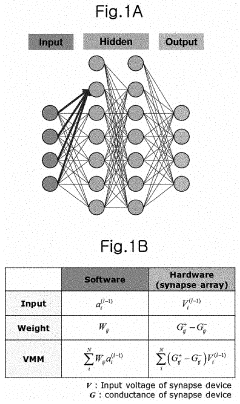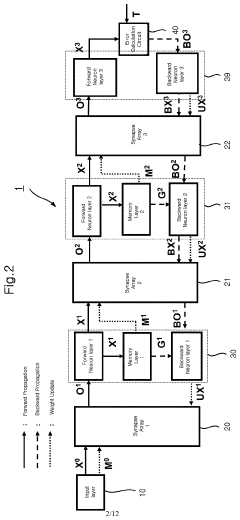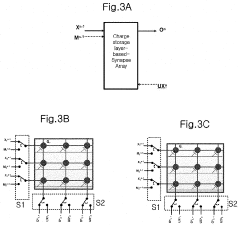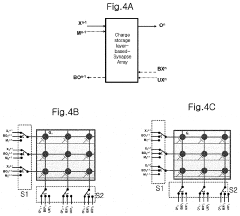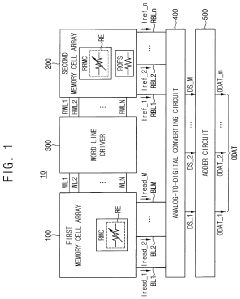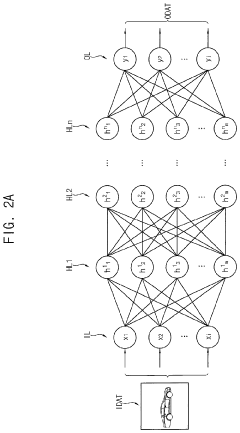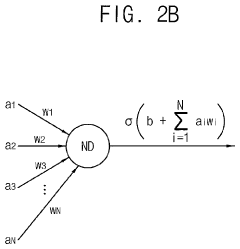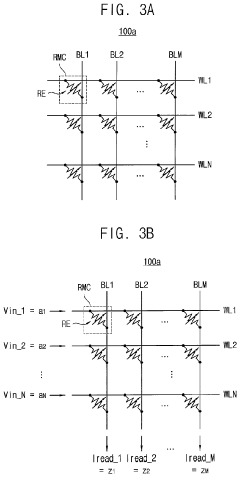Exploring the Applications of Neuromorphic Chips in Education
OCT 9, 202510 MIN READ
Generate Your Research Report Instantly with AI Agent
Patsnap Eureka helps you evaluate technical feasibility & market potential.
Neuromorphic Computing Background and Educational Goals
Neuromorphic computing represents a paradigm shift in computational architecture, drawing inspiration from the structure and function of biological neural systems. Developed in the late 1980s by Carver Mead, this technology aims to mimic the brain's parallel processing capabilities, energy efficiency, and adaptive learning mechanisms. Unlike traditional von Neumann architectures that separate processing and memory, neuromorphic chips integrate these functions, enabling simultaneous data processing across distributed networks of artificial neurons and synapses.
The evolution of neuromorphic computing has progressed through several significant phases. Early implementations focused on analog VLSI circuits that directly emulated neural behaviors. This was followed by the development of digital neuromorphic systems that offered greater programmability while maintaining brain-inspired architectures. Recent advancements have introduced hybrid approaches combining analog and digital elements, as well as the integration of novel materials like memristors that can more accurately replicate synaptic plasticity.
In the educational context, neuromorphic computing presents transformative opportunities. The primary goal of introducing these chips into educational environments is to bridge theoretical neuroscience with practical computing applications, fostering interdisciplinary learning that spans computer science, electrical engineering, neuroscience, and cognitive psychology. This convergence creates a unique platform for students to understand both biological and artificial intelligence principles simultaneously.
Educational objectives for neuromorphic computing implementation include developing hands-on experience with brain-inspired computing paradigms, cultivating computational thinking that transcends traditional programming approaches, and preparing students for emerging careers in neuromorphic engineering and AI. Additionally, these systems aim to demonstrate energy-efficient computing principles that will be crucial for sustainable technology development.
The technical trajectory of neuromorphic computing continues to advance toward more sophisticated neural mimicry, increased scale, and enhanced learning capabilities. Key developments include spike-timing-dependent plasticity (STDP) mechanisms, which enable unsupervised learning similar to biological systems, and the integration of neuromorphic vision and auditory sensors that process sensory information in ways analogous to human perception systems.
As educational institutions increasingly recognize the importance of preparing students for next-generation computing paradigms, neuromorphic chips represent not just a technological tool but a conceptual framework for understanding intelligence itself—both natural and artificial—positioning them as valuable assets in forward-thinking educational curricula.
The evolution of neuromorphic computing has progressed through several significant phases. Early implementations focused on analog VLSI circuits that directly emulated neural behaviors. This was followed by the development of digital neuromorphic systems that offered greater programmability while maintaining brain-inspired architectures. Recent advancements have introduced hybrid approaches combining analog and digital elements, as well as the integration of novel materials like memristors that can more accurately replicate synaptic plasticity.
In the educational context, neuromorphic computing presents transformative opportunities. The primary goal of introducing these chips into educational environments is to bridge theoretical neuroscience with practical computing applications, fostering interdisciplinary learning that spans computer science, electrical engineering, neuroscience, and cognitive psychology. This convergence creates a unique platform for students to understand both biological and artificial intelligence principles simultaneously.
Educational objectives for neuromorphic computing implementation include developing hands-on experience with brain-inspired computing paradigms, cultivating computational thinking that transcends traditional programming approaches, and preparing students for emerging careers in neuromorphic engineering and AI. Additionally, these systems aim to demonstrate energy-efficient computing principles that will be crucial for sustainable technology development.
The technical trajectory of neuromorphic computing continues to advance toward more sophisticated neural mimicry, increased scale, and enhanced learning capabilities. Key developments include spike-timing-dependent plasticity (STDP) mechanisms, which enable unsupervised learning similar to biological systems, and the integration of neuromorphic vision and auditory sensors that process sensory information in ways analogous to human perception systems.
As educational institutions increasingly recognize the importance of preparing students for next-generation computing paradigms, neuromorphic chips represent not just a technological tool but a conceptual framework for understanding intelligence itself—both natural and artificial—positioning them as valuable assets in forward-thinking educational curricula.
Market Analysis for Neuromorphic Technology in Education
The neuromorphic computing market in education is experiencing significant growth, driven by increasing demand for advanced AI capabilities in learning environments. Current market size estimates place the global neuromorphic computing sector at approximately $2.5 billion, with education-specific applications representing about 15% of this market. This segment is projected to grow at a compound annual growth rate of 26% through 2028, outpacing many other technology sectors in education.
The primary market drivers include the growing emphasis on personalized learning experiences, the need for real-time data processing in educational settings, and increasing investments in AI-enhanced educational tools. Educational institutions are increasingly recognizing the potential of neuromorphic chips to process complex sensory data efficiently, enabling more sophisticated learning analytics and adaptive educational systems.
Market segmentation reveals distinct categories within the educational neuromorphic technology space. Higher education institutions currently represent the largest market share (approximately 42%), followed by K-12 schools (28%), corporate training programs (18%), and specialized educational services (12%). Geographically, North America leads adoption with 38% market share, followed by Europe (29%), Asia-Pacific (24%), and other regions (9%).
Consumer demand patterns indicate strong interest in neuromorphic-powered educational tools that offer real-time feedback, adaptive learning paths, and immersive experiences. Educational technology providers are responding by developing neuromorphic-based solutions for language learning, STEM education, special needs education, and cognitive skills development.
Key market barriers include high implementation costs, limited awareness among educational administrators, concerns about data privacy, and the need for specialized technical expertise. The average implementation cost for neuromorphic systems in educational settings ranges from $50,000 to $250,000, depending on scale and complexity, creating adoption challenges particularly for smaller institutions.
Competitive analysis reveals an evolving landscape with both established technology companies and education-focused startups. Major players include Intel (with its Loihi chip), IBM (TrueNorth), BrainChip, and SynSense, alongside education-specific companies like Cognixion, Neurable, and BrainCo. These companies are competing to establish early market leadership through strategic partnerships with educational institutions and content providers.
Market forecasts suggest that neuromorphic technology will become increasingly mainstream in education over the next five years, with particular growth in applications for special education, advanced scientific research, language acquisition, and cognitive assessment tools. The technology's ability to efficiently process sensory data and adapt to individual learning patterns positions it as a potentially transformative force in educational technology.
The primary market drivers include the growing emphasis on personalized learning experiences, the need for real-time data processing in educational settings, and increasing investments in AI-enhanced educational tools. Educational institutions are increasingly recognizing the potential of neuromorphic chips to process complex sensory data efficiently, enabling more sophisticated learning analytics and adaptive educational systems.
Market segmentation reveals distinct categories within the educational neuromorphic technology space. Higher education institutions currently represent the largest market share (approximately 42%), followed by K-12 schools (28%), corporate training programs (18%), and specialized educational services (12%). Geographically, North America leads adoption with 38% market share, followed by Europe (29%), Asia-Pacific (24%), and other regions (9%).
Consumer demand patterns indicate strong interest in neuromorphic-powered educational tools that offer real-time feedback, adaptive learning paths, and immersive experiences. Educational technology providers are responding by developing neuromorphic-based solutions for language learning, STEM education, special needs education, and cognitive skills development.
Key market barriers include high implementation costs, limited awareness among educational administrators, concerns about data privacy, and the need for specialized technical expertise. The average implementation cost for neuromorphic systems in educational settings ranges from $50,000 to $250,000, depending on scale and complexity, creating adoption challenges particularly for smaller institutions.
Competitive analysis reveals an evolving landscape with both established technology companies and education-focused startups. Major players include Intel (with its Loihi chip), IBM (TrueNorth), BrainChip, and SynSense, alongside education-specific companies like Cognixion, Neurable, and BrainCo. These companies are competing to establish early market leadership through strategic partnerships with educational institutions and content providers.
Market forecasts suggest that neuromorphic technology will become increasingly mainstream in education over the next five years, with particular growth in applications for special education, advanced scientific research, language acquisition, and cognitive assessment tools. The technology's ability to efficiently process sensory data and adapt to individual learning patterns positions it as a potentially transformative force in educational technology.
Current State and Challenges of Neuromorphic Chips
Neuromorphic chips represent a significant advancement in computing technology, mimicking the structure and functionality of the human brain. Currently, these chips are primarily in the research and early commercial deployment phases, with major technology companies and research institutions leading development efforts. Intel's Loihi, IBM's TrueNorth, and BrainChip's Akida are among the most prominent neuromorphic computing platforms available today, each demonstrating unique capabilities in pattern recognition, real-time learning, and energy efficiency.
Despite promising developments, neuromorphic technology faces substantial challenges when considering educational applications. The hardware remains relatively expensive and specialized, creating barriers to widespread adoption in educational settings with limited budgets. Additionally, the complexity of neuromorphic architecture requires significant expertise to program and utilize effectively, presenting a steep learning curve for both educators and students without specialized training in neuromorphic computing principles.
The software ecosystem supporting neuromorphic chips is still in its nascent stages, with limited development tools, educational frameworks, and learning resources specifically designed for educational contexts. This underdeveloped ecosystem makes integration into existing educational curricula particularly challenging, as educators lack ready-made materials and pedagogical approaches for teaching with these advanced computing systems.
From a geographical perspective, neuromorphic research and development remains concentrated in a few technological hubs, primarily in North America, Europe, and parts of Asia. This concentration creates disparities in access to neuromorphic technology across different regions and educational institutions, potentially widening the technological divide in educational settings globally.
Technical standardization represents another significant challenge, as different neuromorphic platforms utilize varying architectures, programming paradigms, and interfaces. This fragmentation complicates the development of universal educational materials and transferable skills, potentially limiting the educational value of investments in specific neuromorphic technologies.
Power consumption and physical infrastructure requirements, while significantly improved compared to traditional high-performance computing systems, still present implementation challenges for many educational environments with limited technical infrastructure. Schools and educational institutions often lack the specialized cooling systems, power supplies, and maintenance capabilities needed to support advanced computing hardware.
The integration of neuromorphic chips into education also faces pedagogical challenges, as current educational methodologies and assessment frameworks are not designed to leverage or evaluate the unique capabilities of brain-inspired computing. Educators need new approaches to effectively teach neuromorphic concepts and assess student learning in this emerging field.
Despite promising developments, neuromorphic technology faces substantial challenges when considering educational applications. The hardware remains relatively expensive and specialized, creating barriers to widespread adoption in educational settings with limited budgets. Additionally, the complexity of neuromorphic architecture requires significant expertise to program and utilize effectively, presenting a steep learning curve for both educators and students without specialized training in neuromorphic computing principles.
The software ecosystem supporting neuromorphic chips is still in its nascent stages, with limited development tools, educational frameworks, and learning resources specifically designed for educational contexts. This underdeveloped ecosystem makes integration into existing educational curricula particularly challenging, as educators lack ready-made materials and pedagogical approaches for teaching with these advanced computing systems.
From a geographical perspective, neuromorphic research and development remains concentrated in a few technological hubs, primarily in North America, Europe, and parts of Asia. This concentration creates disparities in access to neuromorphic technology across different regions and educational institutions, potentially widening the technological divide in educational settings globally.
Technical standardization represents another significant challenge, as different neuromorphic platforms utilize varying architectures, programming paradigms, and interfaces. This fragmentation complicates the development of universal educational materials and transferable skills, potentially limiting the educational value of investments in specific neuromorphic technologies.
Power consumption and physical infrastructure requirements, while significantly improved compared to traditional high-performance computing systems, still present implementation challenges for many educational environments with limited technical infrastructure. Schools and educational institutions often lack the specialized cooling systems, power supplies, and maintenance capabilities needed to support advanced computing hardware.
The integration of neuromorphic chips into education also faces pedagogical challenges, as current educational methodologies and assessment frameworks are not designed to leverage or evaluate the unique capabilities of brain-inspired computing. Educators need new approaches to effectively teach neuromorphic concepts and assess student learning in this emerging field.
Current Educational Applications of Neuromorphic Technology
01 Neuromorphic architecture design and implementation
Neuromorphic chips are designed to mimic the structure and functionality of the human brain, with architectures that incorporate neural networks, synaptic connections, and spike-based processing. These designs enable efficient parallel processing and learning capabilities similar to biological neural systems. The implementation includes specialized hardware components that can process information in ways similar to neurons and synapses, allowing for more efficient handling of complex cognitive tasks and pattern recognition.- Neuromorphic architecture design and implementation: Neuromorphic chips are designed to mimic the structure and functionality of the human brain, using specialized hardware architectures that enable efficient processing of neural networks. These designs incorporate parallel processing elements, synaptic connections, and memory components that work together to simulate neural behavior. The architecture typically includes arrays of artificial neurons interconnected through configurable synapses, allowing for efficient implementation of brain-inspired computing paradigms.
- Materials and fabrication techniques for neuromorphic devices: Advanced materials and fabrication techniques are essential for creating neuromorphic chips with desired properties. These include the use of novel semiconductor materials, memristive elements, phase-change materials, and other components that can mimic synaptic plasticity and neural dynamics. Specialized fabrication processes enable the integration of these materials into functional neuromorphic systems, allowing for the creation of energy-efficient and high-performance brain-inspired computing hardware.
- Learning algorithms and training methods for neuromorphic systems: Neuromorphic chips implement specialized learning algorithms that enable them to adapt and learn from data, similar to biological neural systems. These algorithms include spike-timing-dependent plasticity (STDP), reinforcement learning, and other bio-inspired approaches that modify synaptic weights based on neural activity patterns. The training methods are designed to work with the unique characteristics of neuromorphic hardware, optimizing performance while maintaining energy efficiency and computational speed.
- Energy efficiency and power optimization in neuromorphic computing: A key advantage of neuromorphic chips is their potential for extremely low power consumption compared to traditional computing architectures. These chips incorporate various techniques for power optimization, including event-driven processing, sparse activation, and local memory structures that minimize data movement. By processing information in ways similar to the brain, which is highly energy-efficient, neuromorphic systems can perform complex computational tasks while consuming orders of magnitude less power than conventional processors.
- Applications and integration of neuromorphic chips: Neuromorphic chips are being applied across various domains including computer vision, speech recognition, autonomous systems, and edge computing. These applications leverage the unique capabilities of neuromorphic hardware to process sensory data efficiently and make real-time decisions. Integration approaches include hybrid systems that combine neuromorphic processors with conventional computing elements, as well as specialized interfaces for connecting neuromorphic chips with sensors and actuators to create complete intelligent systems.
02 Memory integration in neuromorphic systems
Neuromorphic chips incorporate specialized memory structures that enable efficient storage and retrieval of neural network parameters. These memory systems are designed to support the massive parallelism required for neural computations and often include non-volatile memory technologies that can maintain synaptic weights even when power is removed. The integration of memory and processing elements reduces the data movement bottleneck found in traditional computing architectures, leading to improved energy efficiency and performance for AI applications.Expand Specific Solutions03 Energy-efficient neuromorphic computing
Neuromorphic chips are designed with a focus on energy efficiency, utilizing techniques such as event-driven processing, sparse activations, and low-power circuit designs. By processing information only when necessary and mimicking the brain's energy-efficient information processing methods, these chips can perform complex AI tasks while consuming significantly less power than conventional computing systems. This makes them particularly suitable for edge computing applications where power constraints are critical.Expand Specific Solutions04 Learning and adaptation mechanisms in neuromorphic hardware
Neuromorphic chips incorporate on-chip learning capabilities that allow them to adapt to new information and improve performance over time. These learning mechanisms include spike-timing-dependent plasticity (STDP), reinforcement learning algorithms, and other biologically-inspired approaches that enable the hardware to modify its internal parameters based on experience. The ability to learn directly in hardware reduces the need for frequent retraining and allows for real-time adaptation to changing environments.Expand Specific Solutions05 Applications and integration of neuromorphic technology
Neuromorphic chips are being applied across various domains including computer vision, natural language processing, autonomous systems, and IoT devices. These applications leverage the unique capabilities of neuromorphic hardware such as real-time processing, low power consumption, and adaptive learning. Integration approaches include hybrid systems that combine neuromorphic processors with conventional computing architectures, as well as specialized interfaces that enable neuromorphic chips to interact with sensors, actuators, and other system components.Expand Specific Solutions
Key Industry Players in Neuromorphic Chip Development
The neuromorphic chip market in education is in an early growth phase, characterized by increasing adoption but still evolving applications. Market size remains modest but is expanding rapidly as educational institutions recognize the potential of brain-inspired computing for teaching advanced AI concepts. Technologically, the field shows varying maturity levels across players. Industry leaders like IBM, Samsung, and Hewlett Packard Enterprise are advancing commercial applications, while specialized firms such as Syntiant, Polyn Technology, and Innatera Nanosystems focus on ultra-low power implementations. Academic institutions including Tsinghua University, KAIST, and Zhejiang University are driving fundamental research. The ecosystem is further enriched by collaborations between research organizations like ETRI and CNRS with commercial entities, creating a dynamic landscape poised for significant educational innovation.
SYNTIANT CORP.
Technical Solution: Syntiant has developed the Neural Decision Processors (NDP) series specifically designed for edge AI applications in educational environments. Their NDP200 and NDP120 chips implement neuromorphic principles to process sensory data with extremely low power consumption—as little as 150 microwatts[3]. For educational applications, Syntiant has created the TinyML Education Kit, which includes their neuromorphic hardware along with curriculum materials focused on voice recognition, sound event detection, and sensor data processing. The company's approach emphasizes hands-on learning through practical projects where students can train and deploy neural networks directly on neuromorphic hardware. Syntiant's educational platform includes a simplified programming interface that abstracts the complexity of neuromorphic computing, making it accessible to students without extensive background in neural networks. Their chips enable always-on applications in classroom settings, such as voice-activated educational assistants and interactive learning tools that can operate for extended periods on battery power[4].
Strengths: Syntiant's ultra-low power consumption makes their neuromorphic solutions ideal for battery-powered educational devices and long-term classroom deployments. Their simplified programming interfaces lower the barrier to entry for students and educators new to neuromorphic computing. Weaknesses: The specialized focus on audio and sensor applications may limit the breadth of educational use cases compared to more general-purpose neuromorphic platforms. Their solutions are primarily oriented toward applied learning rather than theoretical neuromorphic principles.
International Business Machines Corp.
Technical Solution: IBM's neuromorphic chip technology, particularly the TrueNorth architecture, has been adapted for educational applications through their "Neuromorphic Devices and Systems for Brain-Inspired Computing" initiative. The TrueNorth chip contains 1 million digital neurons and 256 million synapses, consuming only 70 milliwatts during real-time operation[1]. IBM has developed educational platforms that allow students to experiment with neuromorphic computing concepts through visual pattern recognition, speech processing, and cognitive tasks. Their educational framework includes simulation environments where students can design neural networks that mimic biological processes, providing hands-on experience with brain-inspired computing. IBM has also created curriculum materials for various educational levels, from high school to graduate studies, focusing on neuromorphic principles, programming paradigms, and applications in artificial intelligence[2]. The company has established partnerships with universities to integrate neuromorphic computing into computer science and engineering programs.
Strengths: IBM's extensive research infrastructure and established academic partnerships enable comprehensive educational implementations. Their mature TrueNorth architecture provides reliable performance for classroom demonstrations and experiments. Weaknesses: The complexity of IBM's neuromorphic systems may present a steep learning curve for educational settings without specialized knowledge. Their solutions often require significant computational resources that may exceed typical educational institution budgets.
Core Neuromorphic Architectures and Learning Algorithms
On-chip training neuromorphic architecture
PatentActiveUS20210232900A1
Innovation
- A neuromorphic architecture utilizing synapse arrays with gated Schottky diodes or nonvolatile memory devices, which perform all phases of neural network operations (forward propagation, backward propagation, and weighted value update) using small-sized, low-power-consumption circuits, minimizing memory and area usage.
Neuromorphic computing device and method of designing the same
PatentActiveUS11881260B2
Innovation
- Incorporating a second memory cell array with offset resistors connected in parallel, using the same resistive material as the first memory cell array, to convert read currents into digital signals, thereby mitigating temperature and time dependency, and ensuring consistent resistance across offset resistors for enhanced sensing performance.
Pedagogical Framework for Neuromorphic Computing Education
The integration of neuromorphic computing into educational frameworks requires a structured pedagogical approach that balances theoretical understanding with practical application. Effective neuromorphic education must be built upon a foundation that acknowledges both the interdisciplinary nature of the field and the varying levels of student expertise. This pedagogical framework should incorporate multiple learning dimensions, including cognitive, technical, and experiential components.
Neuromorphic computing education necessitates a progression from fundamental concepts to advanced applications. The initial phase should focus on establishing core principles of neural networks, brain-inspired computing, and spike-based information processing. These foundational elements provide students with the necessary conceptual tools to understand how neuromorphic systems differ from traditional computing architectures.
As students advance, the framework should introduce increasingly complex neuromorphic concepts through project-based learning approaches. This methodology allows learners to engage with real-world applications while developing critical thinking skills specific to neuromorphic system design and implementation. Case studies featuring successful neuromorphic applications in various domains can serve as valuable instructional tools, demonstrating practical relevance and inspiring innovative thinking.
Assessment strategies within this framework must evolve beyond traditional testing methods. Performance-based evaluation that measures students' ability to design, implement, and troubleshoot neuromorphic systems provides more meaningful feedback on learning outcomes. Collaborative projects that simulate industry environments can further enhance the educational experience by fostering teamwork and communication skills essential in professional settings.
The pedagogical framework should also address the unique challenges of teaching neuromorphic computing, including the abstract nature of neural processing and the rapidly evolving technology landscape. Visualization tools and interactive simulations can bridge conceptual gaps, making complex neuromorphic principles more accessible to diverse learners. Additionally, incorporating ethical discussions regarding neuromorphic applications ensures students develop a holistic understanding of the technology's societal implications.
Faculty development represents another crucial component of the framework. Educators require specialized training to effectively teach neuromorphic concepts, particularly as the field continues to evolve. Establishing communities of practice among instructors can facilitate knowledge sharing and pedagogical innovation specific to neuromorphic education.
Ultimately, a successful pedagogical framework for neuromorphic computing education should be adaptable, responsive to technological advancements, and aligned with industry needs. This ensures graduates possess relevant skills for research or professional environments where neuromorphic technologies are increasingly deployed.
Neuromorphic computing education necessitates a progression from fundamental concepts to advanced applications. The initial phase should focus on establishing core principles of neural networks, brain-inspired computing, and spike-based information processing. These foundational elements provide students with the necessary conceptual tools to understand how neuromorphic systems differ from traditional computing architectures.
As students advance, the framework should introduce increasingly complex neuromorphic concepts through project-based learning approaches. This methodology allows learners to engage with real-world applications while developing critical thinking skills specific to neuromorphic system design and implementation. Case studies featuring successful neuromorphic applications in various domains can serve as valuable instructional tools, demonstrating practical relevance and inspiring innovative thinking.
Assessment strategies within this framework must evolve beyond traditional testing methods. Performance-based evaluation that measures students' ability to design, implement, and troubleshoot neuromorphic systems provides more meaningful feedback on learning outcomes. Collaborative projects that simulate industry environments can further enhance the educational experience by fostering teamwork and communication skills essential in professional settings.
The pedagogical framework should also address the unique challenges of teaching neuromorphic computing, including the abstract nature of neural processing and the rapidly evolving technology landscape. Visualization tools and interactive simulations can bridge conceptual gaps, making complex neuromorphic principles more accessible to diverse learners. Additionally, incorporating ethical discussions regarding neuromorphic applications ensures students develop a holistic understanding of the technology's societal implications.
Faculty development represents another crucial component of the framework. Educators require specialized training to effectively teach neuromorphic concepts, particularly as the field continues to evolve. Establishing communities of practice among instructors can facilitate knowledge sharing and pedagogical innovation specific to neuromorphic education.
Ultimately, a successful pedagogical framework for neuromorphic computing education should be adaptable, responsive to technological advancements, and aligned with industry needs. This ensures graduates possess relevant skills for research or professional environments where neuromorphic technologies are increasingly deployed.
Accessibility and Inclusivity Considerations in Implementation
Implementing neuromorphic chips in educational settings requires careful consideration of accessibility and inclusivity factors to ensure these advanced technologies benefit all learners. The inherent adaptability of neuromorphic systems presents unique opportunities to address diverse learning needs through personalized educational experiences.
Neuromorphic technology can be particularly valuable for students with disabilities. For learners with visual impairments, these chips can power haptic feedback systems that translate visual information into tactile experiences. Similarly, for students with hearing impairments, neuromorphic processing can enhance speech-to-text conversion with greater contextual understanding and real-time processing capabilities.
The adaptive learning capabilities of neuromorphic systems enable educational platforms to automatically adjust difficulty levels, presentation formats, and feedback mechanisms based on individual student responses. This adaptability helps address the spectrum of learning styles and cognitive abilities present in any classroom, potentially reducing educational disparities.
Cost considerations remain a significant barrier to equitable implementation. The current high production costs of neuromorphic hardware may limit deployment to well-funded institutions, potentially widening the digital divide. Strategic implementation plans should include provisions for resource-sharing models, such as centralized neuromorphic computing resources that multiple schools can access remotely.
Language diversity presents another implementation challenge. Neuromorphic systems must be designed to support multiple languages and cultural contexts to be truly inclusive. The pattern recognition capabilities of these chips can be leveraged to develop more sophisticated language translation tools that preserve cultural nuances and context.
Educator training represents a critical component of inclusive implementation. Teachers require appropriate professional development to effectively utilize neuromorphic-based educational tools and to adapt these technologies to diverse classroom needs. Without adequate training, even the most advanced technologies may remain underutilized or improperly implemented.
Ethical considerations must guide implementation strategies. Privacy protections are essential, particularly when neuromorphic systems collect and process student performance data. Additionally, algorithmic bias must be actively identified and mitigated to prevent reinforcement of existing educational inequalities or creation of new barriers for underrepresented groups.
Successful implementation requires collaborative approaches involving educators, accessibility experts, neuroscientists, and technology developers. This multidisciplinary collaboration ensures that neuromorphic educational applications address real classroom needs while maintaining technical feasibility and accessibility standards.
Neuromorphic technology can be particularly valuable for students with disabilities. For learners with visual impairments, these chips can power haptic feedback systems that translate visual information into tactile experiences. Similarly, for students with hearing impairments, neuromorphic processing can enhance speech-to-text conversion with greater contextual understanding and real-time processing capabilities.
The adaptive learning capabilities of neuromorphic systems enable educational platforms to automatically adjust difficulty levels, presentation formats, and feedback mechanisms based on individual student responses. This adaptability helps address the spectrum of learning styles and cognitive abilities present in any classroom, potentially reducing educational disparities.
Cost considerations remain a significant barrier to equitable implementation. The current high production costs of neuromorphic hardware may limit deployment to well-funded institutions, potentially widening the digital divide. Strategic implementation plans should include provisions for resource-sharing models, such as centralized neuromorphic computing resources that multiple schools can access remotely.
Language diversity presents another implementation challenge. Neuromorphic systems must be designed to support multiple languages and cultural contexts to be truly inclusive. The pattern recognition capabilities of these chips can be leveraged to develop more sophisticated language translation tools that preserve cultural nuances and context.
Educator training represents a critical component of inclusive implementation. Teachers require appropriate professional development to effectively utilize neuromorphic-based educational tools and to adapt these technologies to diverse classroom needs. Without adequate training, even the most advanced technologies may remain underutilized or improperly implemented.
Ethical considerations must guide implementation strategies. Privacy protections are essential, particularly when neuromorphic systems collect and process student performance data. Additionally, algorithmic bias must be actively identified and mitigated to prevent reinforcement of existing educational inequalities or creation of new barriers for underrepresented groups.
Successful implementation requires collaborative approaches involving educators, accessibility experts, neuroscientists, and technology developers. This multidisciplinary collaboration ensures that neuromorphic educational applications address real classroom needs while maintaining technical feasibility and accessibility standards.
Unlock deeper insights with Patsnap Eureka Quick Research — get a full tech report to explore trends and direct your research. Try now!
Generate Your Research Report Instantly with AI Agent
Supercharge your innovation with Patsnap Eureka AI Agent Platform!
